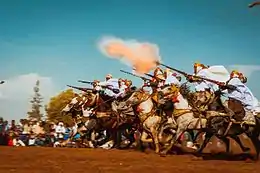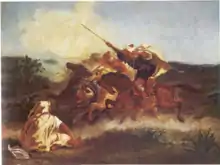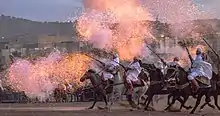Fantasia (performance)
Fantasia (Arabic: الفانتازيا) is a traditional exhibition of horsemanship in the Maghreb performed during cultural festivals and for Maghrebi wedding celebrations.[1][2] It is present in Algeria, Morocco, Tunisia, Libya, Mali, Niger, and Mauritania.[3][2][4]


The performance consists of a group of horse riders, all wearing traditional clothes, who charge along a straight path at the same speed so as to form a line, and then at the end of the charge (about two hundred meters) fire into the sky using old muskets or muzzle-loading rifles. The difficulty of the performance is in synchronizing the movement of the horses during acceleration of the charge, and especially in firing the guns simultaneously so that one single shot is heard.[2] The horses were bred from the Arabian and Barb breeds or a mixture of the two.[5]
The fantasia is considered a cultural performance and a kind of martial art;[6] it also symbolizes a strong relationship between the man (or woman) and the horse, as well as an attachment to tradition.[7] It is historically related to the famous Numidian cavalry charge.
Fantasia performances usually take place during local seasonal, cultural or religious festivals, also called موسم moussem "saint's day festival" in Maghrebi Arabic.
History of the performance
Tbourida comes from the cavalry charge performed by an army's vanguard in battle. It was also used in cavalry raiding and celebrations.[7]
Name
The horse is referred to as a fantasia horse and is of Arabian, Andalusian or Barb stock. The term “fantasia” is of Latin origin, meaning “entertainment”, or Spanish- Italian meaning “fantasy”..[2] Fantasia is also a name used by French Orientalists.[2] The Arabic term mawsim موسم literally means "season".
Fantasia in art
Some French, Sri Lankan and other Western artists have done oil paintings of the fantasia, including Edmon Vales,[8] Eugène Delacroix,[4][9][10] Nasreddine Dinet, Théo van Rysselberghe, Amiru K and Eugène Fromentin.
Moroccan artists such as Hassan El Glaoui have prolifically produced artwork featuring Moroccan riders and horses.[5][11]
Fantasia performances in Algeria
Many of the Algerian troupes perform horse fantasia shows several times a year in different cultural events or mawsims such as "fête Sidi Ahmed Almadjoub" in Naama, Algeria,"fête du cheval" in Tiaret, Algeria, or "fête annuelle Sidi Yahia Bensafia - Ouled N'hare" in Tlemcen, Algeria.
Tbourida in Moroccan sports

Moroccan troupes compete annually for the Hassan II National Tbourida Trophy during the Week of the Horse at the Royal Moroccan Equestrian Federation in Rabat, Morocco. They qualify for the finals through regionally organized competitions through the Federation and SOREC.
See also
References
- Steet, Linda (2000). Veils and Daggers: A Century of National Geographic's Representation of the Arab World. Philadelphia: Temple University Press. p. 141.
- Talley, Gwyneth (2017). Tbourida: Performing Traditional Equestrianism as Heritage Tourism in Morocco. New York: Springer. pp. 219–240.
- Lorenzo, Annie (1988). Cheval et tradition en Afrique du nord. Lausanne: Caracole.
- Sedrati, Azeddine; Tavernier, Roger; Wallet, Bernard (1997). L'art de la Fantasia. Casablanca: Plume.
- Préaudau, Philippe Babier de (1990). Maroc: Les chevaux du Royaume. Panayrac: Daniel Briand.
- Arabies (114-120 ed.). Arabies. 1996. p. 65.
- Gwyneth Talley (2017). ""Gunpowder Women: A Generation Galloping Past the Mudawana"". player.fm (Podcast). Tangier American Legation. Retrieved 21 October 2019.
- "Fantasia au Maroc". artnet.com.
- Prideaux, Tom (1966). The World of Delacroix 1798-1863. New York: Time Incorporated.
- Olmsted, Jennifer W (2009). "The Sultan's Authority: Delacroix, Painting, and Politics at the Alson of 1845". Art Bulletin XCI. 1: 83–106.
- "Moroccan Master Hassan El Glaoui Remembered by his Daughter Touria, Founder of 1-54 Contemporary African Art Fair". Sotheby's. 22 February 2019. Retrieved 20 May 2019.
External links
| Wikimedia Commons has media related to Fantasia (Maghreb). |